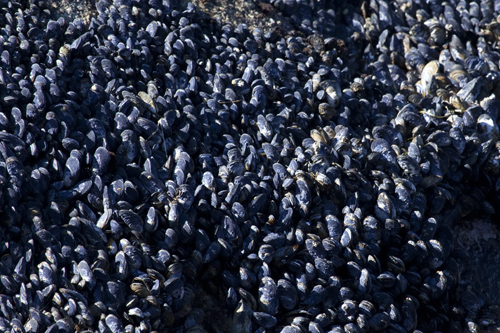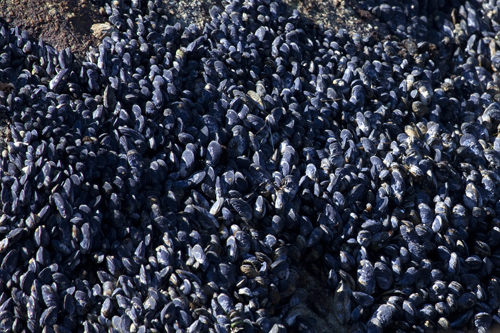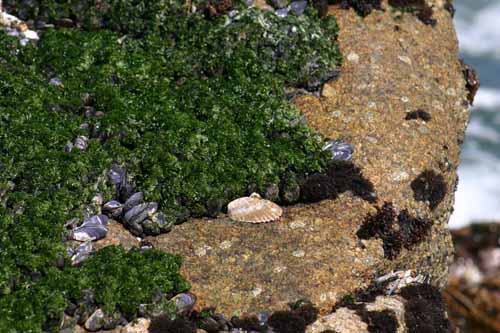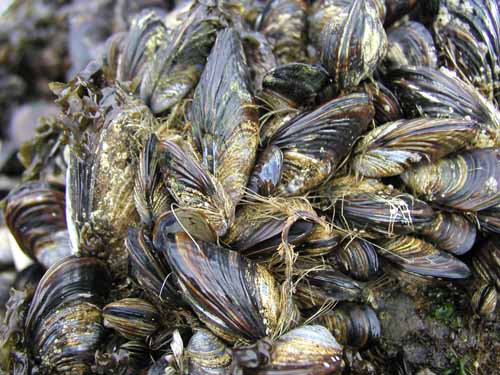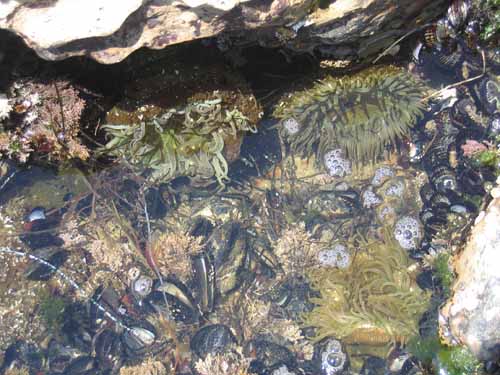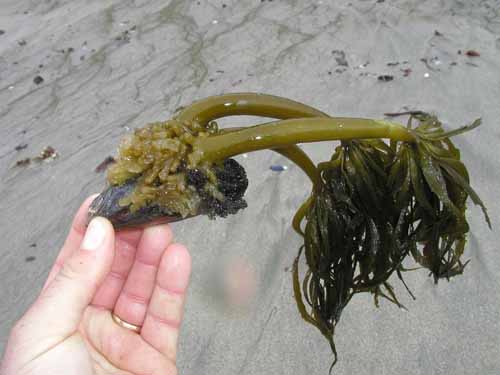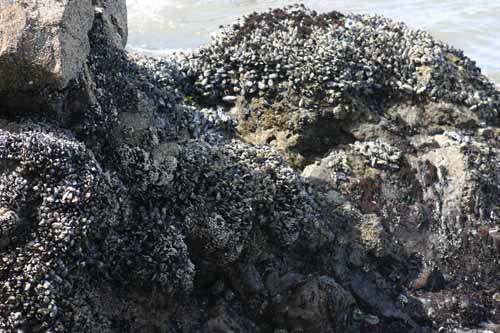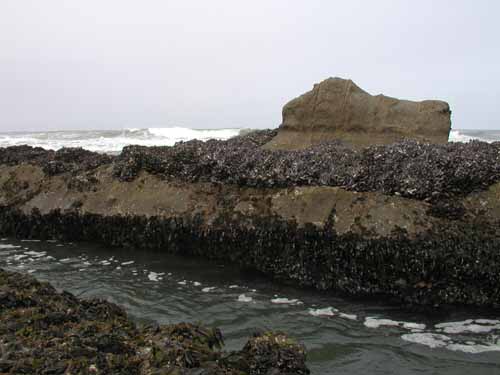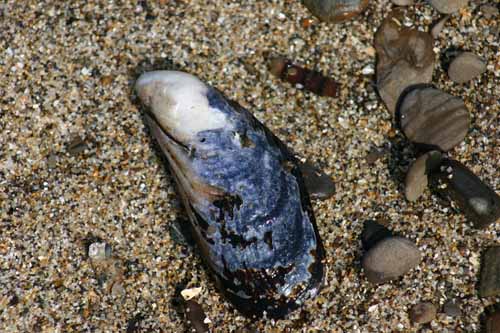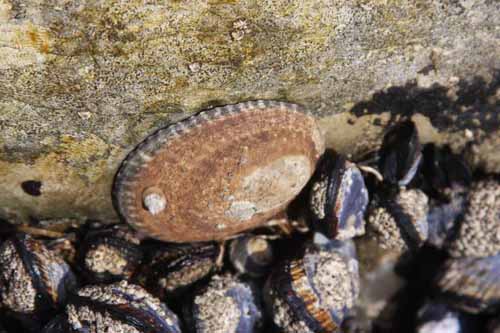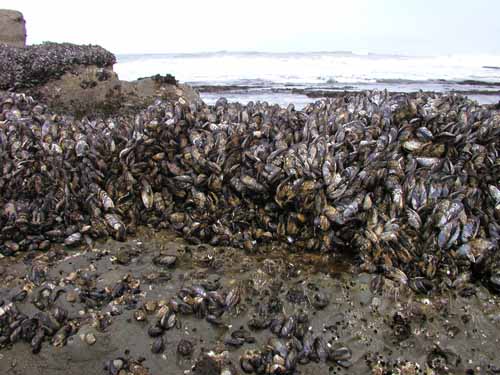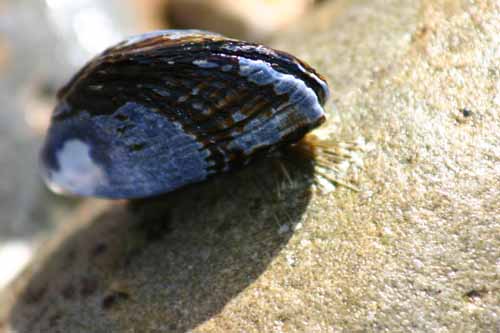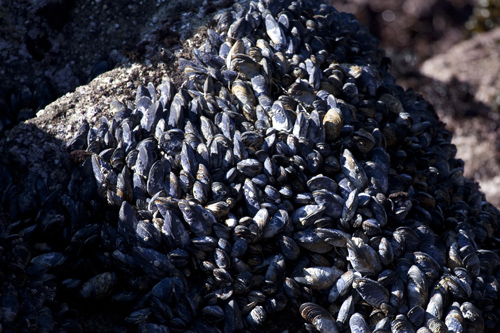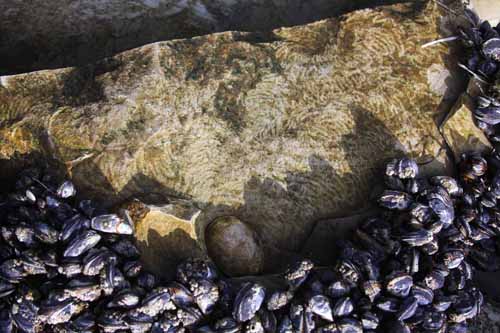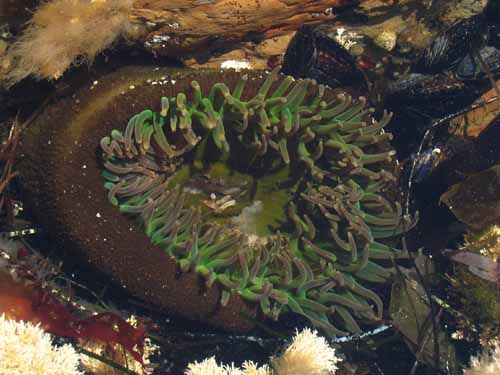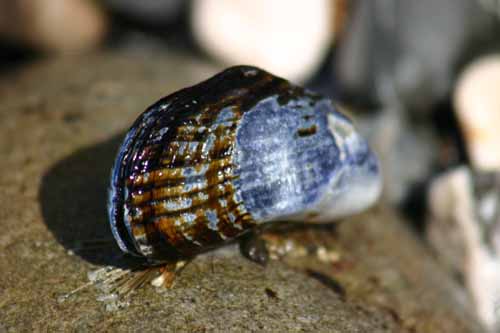
California mussel
Mytilus californianus
Overview
Key Features:
Forms dense mussel beds in the mid-intertidal. Shell is black on the margin and a navy blue in the middle.Similar Species:
Bay mussel, blue mussel (Mytilus edulis)Primary Common Name:
California musselGeneral Grouping:
Clams, mussels, scallopsGeographic Range:
Aleutian Islands, Alaska to Baja California, Mexico
Mytilus californianus occurs from the Aleutian Islands, Alaska to Baja California.Intertidal Height:
-1 to 3 feet (-0.3048 to 0.90090090 meters)Notes:
Mytilus californianus is abundant throughout the mid-intertidal.Subtidal Depth Range:
Minimum Depth: 0 meters or 0 feetMaximum Depth: 26 meters or 86.58 feet
Notes:
Mytilus californianus lives in the subtidal down to 26 m.Habitats:
bay (rocky shore), estuary, exposed rocky shore, kelp forest, protected rocky shoreNotes:
Mytilus californianus lives on rocks and pilings of exposed coasts from the high tide line to 26 m in depth. It only occurs where there is surf.Abundance:
Relative Abundance:
Mytilus californianus is one of the most abundant intertidal animals on the West Coast.Species Description:
General:
Mytilus californianus belongs to the bivalve class in the phylum Mollusca. It occurs in massive clustered growths and is frequently intermixed with the Leaf Barnacle, Pollicipes polymerus. These mussels attach themselves to rock by strong hairlike filaments called byssal threads that are secreted by a gland at the base of the foot. The gland releases liquid that runs down a groove formed by the foot. When the foot pulls back and exposes the liquid to seawater, it becomes solidified into a thread. Large mussels can actually move by breaking old threads and then attaching new ones to another spot.Distinctive Features:
Mytilus californianus has a teardrop shaped shell with several strong concentric grooves and weak radial lines. The shell is brown to dark purple, bluish or black and is often eroded. The umbone, bump just above the hinge of the shell, form an apex at the front end and the rear end is broad and rounded. The foot is slender and orange.Mytilus californianus can be distinguished from the Bay Mussel, Mytilus galloprovincialis/trosullus, which is more common in sheltered habitats, has smooth valves, lacks radiating ridges, and is less eroded.
Size:
Mytilus californianus can grow to a length of 25 cm and a height of 102 mm high. This maximum size, however, is represented by mussels growing in the subtidal since intertidal mussels seldom reach lengths over 13 cm. This species also grows faster in warm southern waters ands considerably slower in the north.Natural History:
General:
Where waves pound the rocks, Mytilus californianus out competes other animals and plants for space, making them competitive dominants. However, many other factors limit their distribution. Their upper limit is set by desiccation and nutritional stress and possibly competition. Their lower limit is influenced by predation by Pisaster ochraceus and probably other predators as well as competition with algae and low intertidal invertebrates. Storm waves also play a big role on mussels, often ripping off large patches of mussels from the beds, especially if they have been weakened by sea star predation.Due to their amazing filtering capabilities, mussels serve as sensitive monitors of chemical troubles in the environment. The United States Mussel Watch Program uses Mytilus californianus and others to detect minute, but dangerous levels of environmental toxins in seawater. They specifically look at organic pollutants and heavy metals, such as lead and cadmium. A moderate-sized mussel bed can filter an estimated 24 million metric tons of seawater in a year, concentrating pollutants in the animals' tissues all the while.
In California, Mytilus californianus and all other bivalve mollusks are quarantined from May through October because of red tides. Red tides are caused by blooms of dinoflagellates and diatoms that are especially likely to occur during these months. Several species of dinoflaggellates produce a potent neurotoxin that shellfish like Mytilus californianus assimilate and temporarily store. When people eat their contaminated tissue, paralytic shellfish poisoning results and can cause paralysis and death.
Predator(s):
Mytilus californianus is eaten by sea stars, especially the Ochre Sea Star, Pisaster ochraceus, predatory snails, crabs, shorebirds, and sea otters. It is also collected by humans for food.Prey:
Mytilus californianus feeds on suspended food particles such as detritus and phytoplankton.Feeding Behavior:
Sessile suspension feederNotes:
Unlike other mollusks, Mytilus californianus and their bivalve relatives do not have a radula. Instead, these mussels trap particles with their gills. They hold their valves slightly open, pump seawater into their mantle cavity and then filter it through their gills. The flow of water is generated by the beat of millions of cilia on their gills. The gills sort and trap food particles, which are then passed along elaborate grooves to the mouth.Seasonal Behavior
January - December
Reproduction:
Mytilus californianus breeds throughout the year, although peaks have been noted during July and December in California. The sexes are separate, and like many bottom-dwelling invertebrates, they synchronize their spawning with phytoplankton blooms. This ensures their larvae will develop when there is plenty of food for them to eat. It also minimizes larval mortality since during the onset of phytoplankton blooms, predatory zooplankton are at a yearly low. Larval recruitment varies over time and place. Studies have shown it is enhanced by the presence of barnacles, mussel byssal threads, and the alga Endocladia, but impaired by the grazing activities of limpets.References
- Alden, P., F. Heath, R. Keen, A. Leventer, and W. Zomlefer. 2002. National Audubon Society Field Guide to California. A.A. Knopf, New York, NY.
- Langstroth, L. and L. Langstroth. 2000. A Living Bay: The Underwater World of Monterey Bay. University of California Press, Berkeley and Los Angeles, CA. 287 p.
- MARINe. 2004 (Updated 12/09/04). Multi-Agency Rocky Intertidal Network. World Wide Web electronic publication, http://www.marine.gov, Accessed [04/22/06]
- Meinkoth, N.A. 1998. National Audubon Society Field Guide to North American Seashore Creatures. A.A. Knopf, New York, NY. 813 p.
- Ricketts, E. F., J. Calvin, and J.W. Hedgpeth. 1985. Between Pacific tides. Stanford University Press, Stanford, CA. 652 p.
- Smith, J.R., and D.R. Strehlow. 1983. Algal-induced spawning in the marine mussel Mytilus californianus. International Journal of Invertebrate Reproduction 6: 129-133.
- WWW
Monterey Bay Aquarium. Online Field Guide, 2008.
http://www.mbayaq.org/efc/living_species/
Accessed [04/27/06]
Accessed 01/30/2009 for Pelagic Cormorant
Accessed 8/19/09 for Bryozoan
Accessed 7/31/09 for Spiny brittle star
Accessed 3/31/09 for Sunflower star
Accessed 8/9/09 for red octopus
Accessed 8/19/09 for Decorator crab
Accessed 7/31/09 for warty sea cucumber
Related Information
Photo Library
Click on an image below to view a larger version in the SIMoN Photo Library. You will also be able to view important information on each photo such as photographer, date, caption and more
